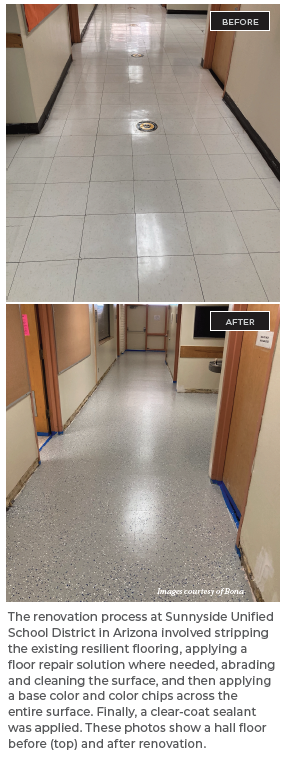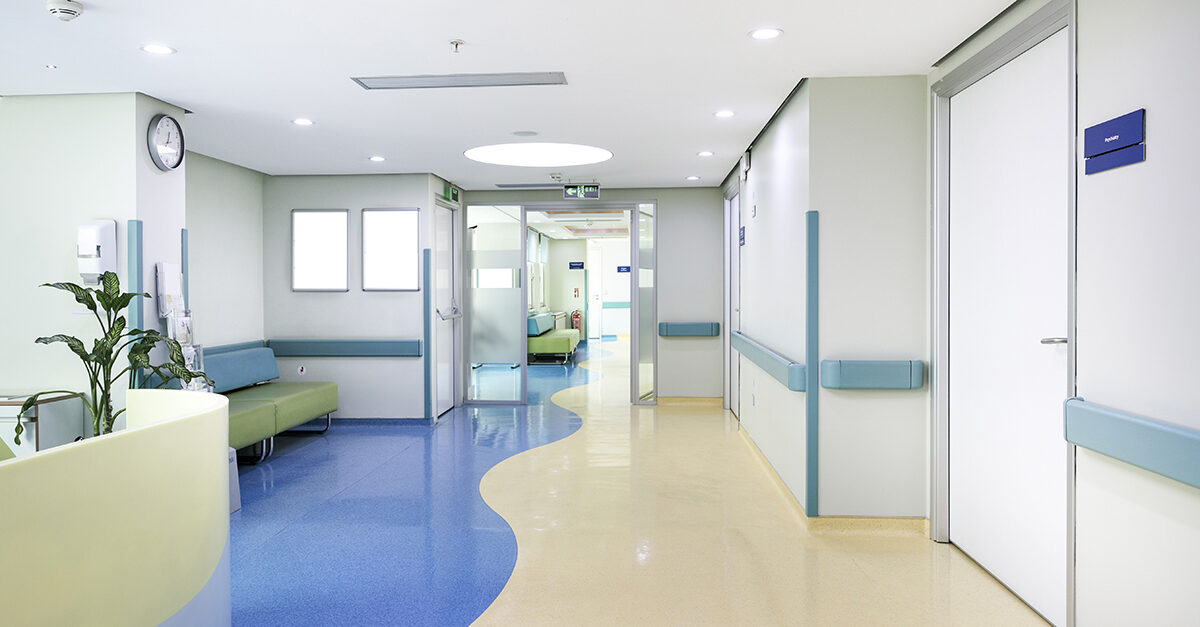Facility management professionals in industries such as health care, retail, education, and government are often involved in the process of renovating their existing facilities or moving into historical buildings that require renovation. One of the first decisions to be made during a building overhaul is, “Do we keep the floors or scrap them and install new?”
The IVL Swedish Environmental Research Institute (IVL) recently conducted a study to better understand the environmental impact of refinishing compared to replacing hardwood or resilient (i.e., linoleum, rubber, vinyl) flooring materials. The study found that renewing resilient floor surfaces can offer:
- Up to a 92% reduction in a facility’s carbon footprint when compared to floor replacement
- A 95% savings in energy resources, measured by transportation, electricity use, consumables, and materials.
Sustainability is a key driver in construction today. Many architects, designers, and facility managers are now converting dilapidated, scratched, faded, and just plain ugly flooring into beautiful, environmentally safe, durable, and budget-friendly showpieces.
However, project stakeholders—upon seeing the condition of some facility flooring surfaces—often consider a renovation to be an unsurmountable challenge and opt to replace instead. As a result, companies contribute to overflowing landfills, lengthen the construction timeline, ruin their budgets, and subject those nearby to harmful fumes.
In today’s reality of new flooring trends, floors can be successfully renovated—regardless of their existing condition—and efficiently maintained for a long-lasting life. Here are three key actions shaping floor renovation that offer cost-effective, time-saving, and stylish solutions.
Keep flooring out of the landfills
The IVL study found that 27 million square feet (25 million square meters) of flooring is replaced annually in Swedish public and commercial buildings, and other countries see similar numbers.
“The norm today is new and fresh, and refinishing is often perceived as more difficult,” said Maria Ahlm, author of the report at the IVL Swedish Environmental Institute.
When it’s time to remodel the facility, or if the resilient flooring is damaged to the point of being hazardous, the historic tendency is to tear the flooring out. Landfills receive the majority of this non-biodegradable material. In addition to creating more landfill waste, replacing flooring surfaces is expensive and time consuming. Add the current pandemic-related supply chain issues to this list, and facilities could be facing a long wait to achieve safe and attractive replacement floors.
However, renovating existing surfaces is an innovative, growing option with many benefits, including a reduced environmental impact.
For example, the sheet vinyl flooring in North Carolina-based Kadlec Regional Medical Center’s medication room was worn from heavy foot traffic, medical equipment transportation, and harsh chemical cleaning processes. Replacement costs were estimated at US$7,000 and included three days of downtime. Seeking a budget-friendly solution, the facility maintenance team decided to renovate the existing floor.
The process—which included abrading, cleaning, applying a base color and a design with color chips, then adding a finish coat—took five hours and cost approximately $600. The room was back in service the following day, with a monolithic floor surface that prevents germs, contaminants, and other materials from seeping into cracks or dulling the appearance.

Avoid toxic floor stripping
We’ve all seen resilient flooring that becomes dull, slippery, or damaged with wear and tear. At this point—and when budgets allow—most facility managers either choose to polish or replace the flooring.
The polishing process is labor intensive and involves the use of harmful chemicals that can end up in the air and waterways. For these reasons, often facilities teams must close the area to be renovated to staff, guests, and business operations, or wait until a holiday or weekend and pay maintenance teams overtime to complete the work.
Identifying solutions that allow maintenance teams to efficiently and safely maintain resilient flooring is top of mind for facility managers. They realize flooring is susceptible to deterioration from heavy traffic, spills, extreme heat, excessive moisture, and harsh cleaners. It can be scratched or dented from furniture and heavy equipment. Therefore, evaluating the cost of the flooring throughout its lifetime, as well as the environmental impact of frequent stripping, are both important considerations.
New options to fully renovate and transform resilient surfaces eliminate the need to endure the time-intensive and highly toxic stripping process, after the initial system application. Long-term benefits include minimized facility downtime (often cut by 50%), less labor costs for polish upkeep, and extended life of the resilient surface.
Improve air quality with waterborne chemistries
Waterborne floor renovation systems are a viable solution for facility managers seeking practicality and sustainability in floor care. These products are:
Environmentally friendly. Not only do waterborne products eliminate the need to strip resilient flooring surfaces, but they are also less likely to emit volatile organic compounds (VOCs) into the air, making them safer for maintenance teams and others in the building. When evaluating environmentally safe chemistries, facility managers should look for products that are UL GREENGUARD Certified for low chemical emissions, as they help reduce indoor air pollution.
Budget-friendly. Renovation saves time and dollars compared to a new floor installation. New resilient finish systems available today will provide a durable surface with minimal downtime for facility staff and guests, and help facilities avoid a lengthy and costly construction process.
Durable. Waterborne solutions are now an industry standard for durable, long-lasting floor surfaces. Additionally, most resilient renovation systems offer a clean, non-yellowing formula to keep the floor looking new for years with the ability to also change the color and design of the floor.
Resilient flooring is a steadily growing market. According to a study by The Freedonia Group, global demand for resilient flooring will grow to 3.9 billion square feet in 2022.
As the resilient industry evolves and our focus on sustainability continues to grow, facilities will need to change renovation, replacement, cleaning, and maintenance practices. New products and techniques will allow them to make these changes without compromising the quality of their floors.



